
Catalog excerpts

Implants trauma Distal Ulna Locking Plate
Open the catalog to page 1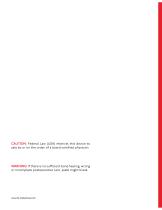
CAUTION: Federal Law (USA) restricts this device to sale by or on the order of a board certified physician. WARNING: If there is no sufficient bone healing, wrong or incomplete postoperative care, plate might break.
Open the catalog to page 2
1. Introduction P. 5 Preface P. 6 Screws P. 7 Properties P. 8 Indications & Contraindications P. 8 Time of operation 2. Surgical Technique P. 10 Positioning of the patient P. 10 Exposure P. 11 Plate insertion P. 12 Placement of the screws P. 15 Postoperative treatment P. 15 Explantation P. 15 Summary 3. Information P. 17 Locking P. 17 Dotize® P. 18 Order list P. 20 Sterilization guidelines P. 22 Notes
Open the catalog to page 3
Preface The Distal Ulna Locking Plate is a plate system which can be installed with locking screws adjusted to the contour of the distal ulna. The plate is concealed by the muscles due to its palmar location. Consequently, metal removal is not always necessary. The ulnar head is stabilized using locking screws. The junction to the neck region is supported via the plate configuration. Use of locking screws in the proximal section increases rigidity.
Open the catalog to page 5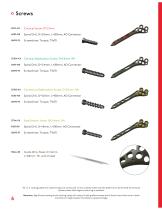
Spiral Drill, D=2.0mm, L=100mm, AO Connector Cortical Stabilization Screw, D=3.0mm, RH Spiral Drill, D=2.4mm, L=100mm, AO Connector Cancellous Stabilization Screw, D=3.0mm, RH Spiral Drill, D=2.0mm, L=100mm, AO Connector Spiral Drill, D=1.8mm, L=100mm, AO Connector Guide Wire, Steel, D=1.6mm, L=150mm, TR, with thread All I.T.S. locking plates are anatomically pre-contoured. In the unlikely event that the plate has to be formed to the bone please notice that slight contouring is possible. Attention: Significant bending at the locking holes will reduce locking effectiveness and if bend more...
Open the catalog to page 6
Properties Properties of the material: • Plate material: Titanium • Material of screws: TiAl6V4 ELI • Easier removal of implant after fracture has healed • Improved fatigue strength of implant • Reduced risk of cold welding • Reduced risk of inflammation and allergy Multi-directional locking Anatomically plate design Version left/right Version wide/small K-Wire holes for preliminary plate fixation 5 distal plate holes for optimal reconstruction of the distal radio-ulnar joint (DRUJ) Long hole for optimal positioning and adjustment of ulna length Pointed proximal plate end for percutaneous...
Open the catalog to page 7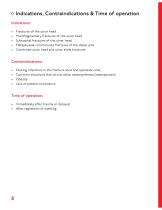
Indications, Contraindications & Time of operation Indications: • • • • • Fractures of the ulnar head Multifragmentary fractures of the ulnar head Subcapital fractures of the ulnar head Metaphyseal comminuted fractures of the distal ulna Combined ulnar head and ulnar shaft fractures Existing infections in the fracture zone and operation area Common situations that do not allow osteosynthesis (osteoporosis) Obesity Lack of patient compliance Time of operation: • Immediately after trauma or delayed • After regression of swelling
Open the catalog to page 8
Surgical Technique
Open the catalog to page 9
Positioning of the patient • The patient is placed in the supine position with pneumatic deprivation of blood supply • The hand is positioned on a x-ray transparent surgical hand table Exposure • The skin incision is made approx. 5mm to the palmar side of the mid lateral line from the tip of the ulna head handle to 5-7cm proximally. • After sectioning of the skin and the subcutis, outline the superficial branch and the ulnar nerve in the distal region. • Sharply separate the pronator quadratus muscle on the ulnar side and hold subperiostally medially. • The fracture area is outlined and...
Open the catalog to page 10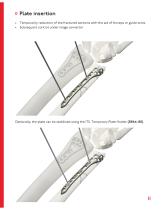
Plate insertion • Temporarily reduction of the fractured sections with the aid of forceps or guide wires • Subsequent control under image convertor Optionally, the plate can be stabilised using the ITS. Temporary Plate Holder (58164-150).
Open the catalog to page 11
Placement of the screws With the spiral drill, D=2.0mm, L=100mm, AO Connector (61203-100), drill through the drill guide, D=2.0/2.4mm (62215) into the long-hole. Determine appropriate length using the depth gauge, PROlock II (59026). Insert the D=2.7mm cortical screw (32271-XX) with the screwdriver, Torque, T9x70 (5609570). Advice: For optimal alignment of the plate with ulna length, we recommend to first occupy the longhole.
Open the catalog to page 12
Then insert a D=2.4mm stabilization screw, RH (37241-XX) or a D=3.0mm cancellous stabilization screw, RH (37303-XX) with the screwdriver, Torque, T9x70 (56095-70) into a distal plate hole. (Spiral drill, D=1.8mm, L=100mm, AO Connector (61183-100) for D=2.4mm stabilization screw / spiral drill, D=2.0mm, L=100mm, AO Connector (61203-100) for D=3.0mm cancellous stabilization screw) Use the screwdriver, Torque, T9x70 (56095-70) to insert a D=3.0mm cortical stabilization screw, RH (37304-XX) of appropriate lengths determined previously with the depth gauge, PROlock II (59026) into a shaft plate...
Open the catalog to page 13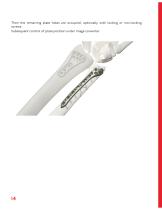
Then the remaining plate holes are occupied, optionally with locking or non-locking screws. Subsequent control of plate position under image converter.
Open the catalog to page 14
Postoperative treatment • Dorsal splint (1-2 weeks) • With mobilisation stability: physiotherapy possible in the immediate postoperative period Explantation If desired by the patient, the implant can be removed. Removal should be performed at the earliest one and a half years later or after radiographic verification of the healed bone. The problem of cold welding was solved by using a special treatment (for further information see page 17). Summary The ITS. Distal Ulna Locking Plate is proven in the osteosynthesis of the most diverse of fractures of the distal ulna. This technique attains...
Open the catalog to page 15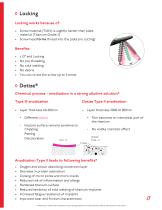
Locking Locking works because of: • Screw material (TiAlV) is slightly harder than plate material (Titanium Grade 2) • Screw head forms thread into the plate (no cutting) ± 15° and Locking No pre threading No cold welding No debris You can re-set the screw up to 3 times Dotize® Chemical process - anodization in a strong alkaline solution* Type III anodization Dotize Type II anodization + Film becomes an interstitial part of the titanium - Implant surface remains sensitive to: Chipping Peeling Discoloration Type - III - No visible cosmetic effect Dotize® Type - II Ti-Oxid Anodization Type II...
Open the catalog to page 17All I.T.S. catalogs and technical brochures
-
ufs
1 Pages
-
DHL
2 Pages
-
ITS
2 Pages
-
PHL
24 Pages
-
ACLS
20 Pages
-
CFN
32 Pages
-
OLS
24 Pages
-
PHLs
20 Pages
-
CTN - Cannulated Tibia Nail
28 Pages
-
SR Sacral Rods
20 Pages
-
HCS
24 Pages
-
TOS Twist-Off Screw
20 Pages
-
TLS
20 Pages
-
PRS-RX
32 Pages
-
HLS
20 Pages
-
ES
20 Pages
-
SR
20 Pages
-
FL
24 Pages
-
PL - Pilon Locking Plate small
12 Pages
-
OL - Olecranon Locking Plate
24 Pages
-
CAS
40 Pages
-
FCN
20 Pages
-
HOL
24 Pages
-
FLS
24 Pages
-
PFL
20 Pages
-
DTL
24 Pages
-
HTO
24 Pages
-
PTL
32 Pages
-
DFL
32 Pages
-
SCL
32 Pages
-
SLS
24 Pages
-
CAL
20 Pages
-
CLS
28 Pages



























































